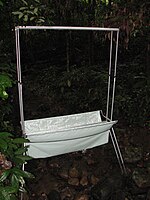
A harp trap is a device used to capture bats without exposing them to disentangling from traps like mist nets and hand nets. It capitalizes on bats' flight characteristic of turning perpendicular to the ground to pass between obstacles, in this case the trap's strings, in which flight attitude they cannot maintain their angle of flight and drop unharmed into a collection chamber. Invented in 1958 by US Public Health Service veterinarian Denny Constantine, the harp trap has been modified for different applications and efficiencies by users, including Merlin Tuttle's double harp trap in 1974, Charles Francis' 4-frame harp trap in 1989, and other modifications improving collapsibility and portability.
The harp trap is a significant tool for measuring aspects of bat ecology, most notably to obtain information about bat populations and movement for public health and conservation management purposes. Even though visually apparent when set out in the open, harp traps are effective if placed where natural features funnel bats toward the trap. They can be set across flyways in heavily wooded areas, over small bodies of water, and at roost entrances, and can be left unattended for periods of time, allowing multiple sites to be worked simultaneously. They can be more efficient for surveying bats than mist nets, capturing higher numbers of species and individuals.
References
- ^ V. C. Ashton. 2004. "Design and Use of a Harp Trap for Assessment of Resident Microchiropteran Species and Associated Ectoparasites at Stinking Hole, Dominica." Texas A&M University Archbold Tropical Research and Education Center Study Abroad Program in Dominica, Study Abroad 2004.
- D. G. Constantine. 1958. "An automatic bat-collecting device." Journal of Wildlife Management 22(1):17–22. doi:10.2307/3797291. JSTOR 3797291.
- M. D. Tuttle. 1974. "An improved trap for bats." Journal of Mammalogy 55(2): 475–477. JSTOR 1379025.
- ^ Charles M. Francis. 1989. "A Comparison of Mist Nets and Two Designs of Harp Traps for Capturing Bats." Journal of Mammalogy 70(4): 865–870. JSTOR 1381730.
- ^ C. R. Tidemann & D. P. Woodside. 1978. "A collapsible bat-trap and a comparison of results obtained with the trap and with mist-nets." Australian Wildlife Research 5:355–362. doi:10.1071/WR9780355.
- N. Berry, W. O'Connor, M. W. Holderied, and G. Jones. 2004. "Detection and Avoidance of Harp Traps by Echolocating Bats." Acta Chiropterologica 6(2): 335–346, accessed 19 Jun 2012. doi:10.3161/001.006.0211.
- ^ A. M. Duffy, L. F. Lumsden, C. R. Caddle, R. R. Chick & G. R. Newell. 2000. "The efficacy of Anabat ultrasonic detectors and harp traps for surveying microchiropterans in south-eastern Australia." Acta Chiropterologica 2: 127–144.
- D. G. Constantine & B. Villa R. 1962. "Métodos de lucha contra los vampiros transmisores de la rabia". Boletín de la Oficina Sanitaria Panamericana 53(1):7–12, 1962.
- D. G. Constantine. 1969. "." Boletín de la Oficina Sanitaria Panamericana 67: 39–42.
- C. L. Hourigan, C. P. Catterall, D. Jones, and M. Rhodes. 2008. "A comparison of the effectiveness of bat detectors and harp traps for surveying bats in an urban landscape." Wildlife Research 35: 768–774. doi:10.1071/WR07154.
- ^ S. Churchill. 1998. Australian bats Sydney, Australia: Reed New Holland.
External links
| Wildlife and animal trapping | ||
|---|---|---|
| Terrestrial animals |  | |
| Insects and invertebrates | ||
| Birds and bats | ||
| Fishing | ||
| Related articles | ||
| [REDACTED] Media related to Traps at Wikimedia Commons | ||